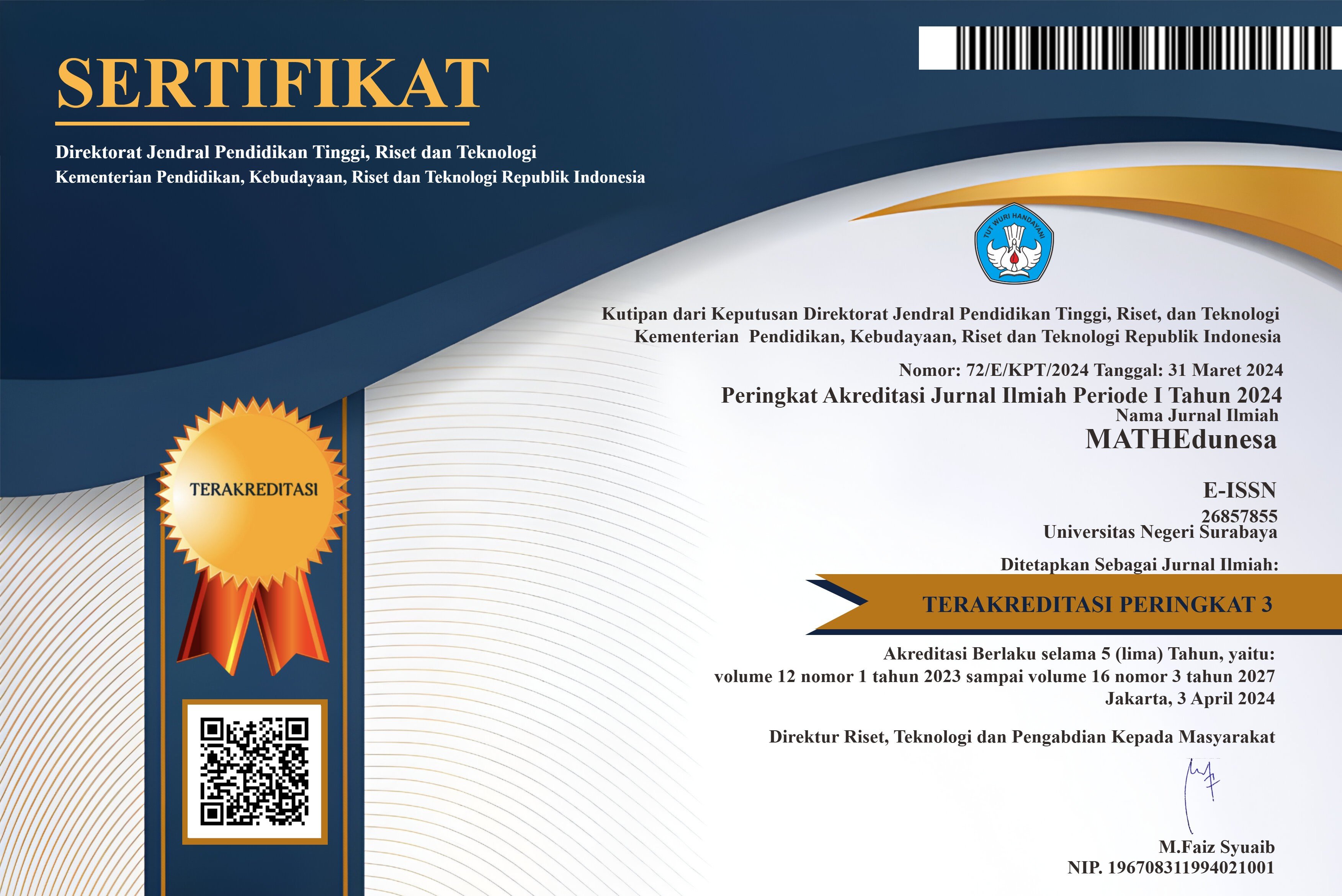PROFIL BERPIKIR KRITIS SISWA SMP DALAM MEMECAHKAN MASALAH MATEMATIKA DITINJAU DARI GAYA KOGNITIF DAN JENIS KELAMIN
DOI:
https://doi.org/10.26740/mathedunesa.v6n2.p%25pAbstract
Abstrak
Kemampuan berpikir kritis siswa dalam menyelesaikan permasalahan merupakan salah satu tujuan
pembelajaran matematika. Kemampuan berpikir kritis siswa dapat dikembangkan melalui pemberian
masalah matematika, salah satunya adalah materi perbandingan. Strategi yang digunakan dalam
memecahkan masalah dapat dipengaruhi oleh gaya kognitif. Selain gaya kognitif, perbedaan jenis
kelamin juga diduga memengaruhi kemampuan berpikir kritis siswa.
Penelitian ini merupakan penelitian deskriptif kualitatif yang bertujuan untuk mendeskripsikan
profil berpikir kritis siswa SMP dalam memecahkan masalah matematika ditinjau dari gaya kognitif dan
jenis kelamin. Subjek penelitian ini terdiri dari 4 siswa kelas VII SMP dengan kemampuan matematika
setara, di antaranya 1 siswa laki-laki reflective, 1 siswa perempuan reflective, 1 siswa laki-laki impulsive,
dan 1 siswa perempuan impulsive. Teknik pengumpulan data dilakukan dengan cara pemberian tes gaya
kognitif (MFFT), tes kemampuan matematika, tes pemecahan masalah matematika, dan wawancara. Data
dianalisis berdasarkan indikator kategori berpikir kritis (klarifikasi, asesmen, inferensi, strategi) pada
setiap langkah pemecahan masalah (memahami masalah, menyusun rencana, melaksanakan rencana,
memeriksa kembali).
Hasil penelitian menunjukkan bahwa profil berpikir kritis keempat subjek pada langkah
memahami masalah relatif sama. Pada kategori klarifikasi, keempat subjek menganalisis ruang lingkup
permasalahan, mengidentifikasi asumsi pokok dari permasalahan, mendefinisikan istilah-istilah yang
relevan, mengidentifikasi hubungan bagian permasalahan. Pada langkah menyusun rencana, keempat
subjek melaksanakan semua indikator kategori asesmen. Siswa laki-laki reflective melaksanakan semua
indikator pada kategori strategi, sedangkan siswa perempuan reflective tidak mendiskusikan langkah yang
mungkin, siswa laki-laki dan perempuan impulsive tidak mendiskusikan langkah yang mungkin dan tidak
memprediksi hasil dari langkah yang dibuat. Pada langkah melaksanakan rencana, keempat subjek
menyusun hubungan antara bagian berbeda dari permasalahan, membuat kesimpulan sesuai hasil diskusi,
memikirkan kesimpulan dengan benar. Pada langkah memeriksa kembali, subjek laki-laki dan perempuan
reflective mengevaluasi langkah penyelesaian yang telah dilakukan, sedangkan subjek laki-laki dan
perempuan impulsive tidak mengevaluasi langkah penyelesaian yang telah dilakukan.
Kata Kunci: Berpikir Kritis, Pemecahan Masalah Matematika, Gaya Kognitif, Jenis Kelamin.
Abstract
Students’ critical thinking ability on problem solving is one of the mathematics learning
objectives. Students’ critical thinking ability can be developed by giving mathematics problem. One of
them is proportion problem. The strategy that is used to solve the problem can be affected by cognitive
style. Besides that, sex differences also have influenced in students’ critical thinking.
This research is qualitative-descriptive research with aims to described profile of junior high
school students’ critical thinking on mathematics problem solving based on cognitive style and sex
differences. The subjects are students of grade 7th with the same mathematics competence that is
consisted of a male and a female students who have reflective cognitive style, and a male and a female
students who have impulsive cognitive style. The data were collected by giving cognitive style test
(MFFT), mathematics competence test, problem solving test, and interview. The data were analyzed by
using indicator of critical thinking’s category (clarification, assessment, inference, strategies) for each
step of problem solving (understanding the problem, devising a plan, carrying out the plan, looking back).
The results showed that profile of four students’ critical thinking on the understanding problem
relatively same. On clarification, they analyzed the scope of the problem, identified the main assumption
of the problem, defined the relevant terms, and identified relationship among the parts in the problem. On
devising a plan, all of the subjects did assessment category. A male student who has reflective cognitive
style did the entire indicator on strategy category meanwhile a female student who has reflective
cognitive style didn’t discuss possible steps. A male and a female students who have impulsive cognitive
style also didn’t discuss possible steps and didn’t predict the result of the plan that they made. On
carrying out the plan, subjects framed relationships among the different parts of the problem, made
conclusions based on their discussion, and thought the conclusion well. On looking back, a male and a
female students who have reflective cognitive style evaluated the step that was done meanwhile a male
and a female students who have impulsive cognitive style didn’t evaluate the step that was done.
Keywords: Critical Thinking, Mathematics Problem Solving, Cognitive Style, Sex.
Downloads
Downloads
Published
Issue
Section
 Abstract views: 82
,
Abstract views: 82
, PDF Downloads: 909
PDF Downloads: 909




